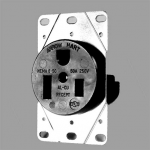I figured he was referring to dual fuel ranges, where you have an electric convection oven and a gas cooktop all in one range.
In that case we could have the old 3-wire style range receptacle, the N-G bond in the range would be bonding a neutral to a gas pipe.
Now say the service looses a neutral to the building in a storm but the two hots are undamaged, typical if a messenger wire snaps, one could see significant current on that gas pipe.
Fortunately the last dual fuel range I installed was a '240V' model, the neutral was not connected to anything:
The Wolf 36" Dual Fuel Range 4 Burner Infrared Charbroiler (DF36450C/S/P) Gourmet Mode features nearly 50 presets that automatically control the oven to ensure delicious results.

www.subzero-wolf.com
So if it was connected to an old SE cable all one would need to do is swap out a NEMA 10-50 to a 6-50 receptacle.
Wich I really think should be the solution for all these.
View attachment 2562280

